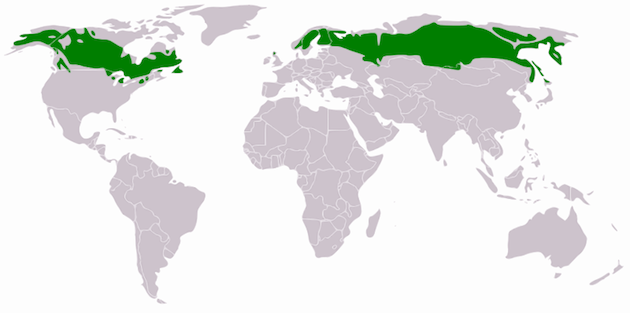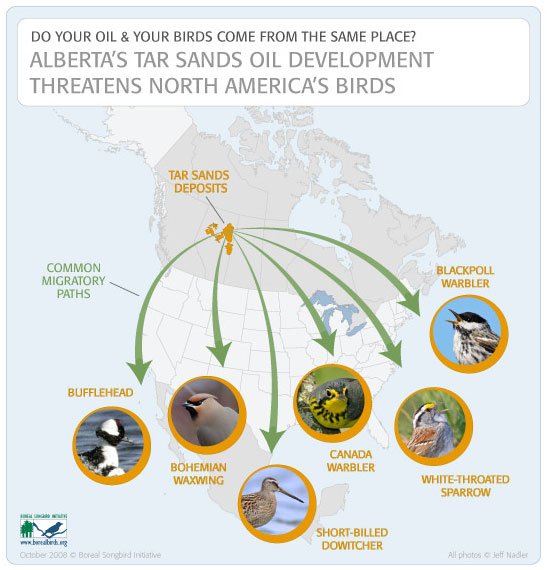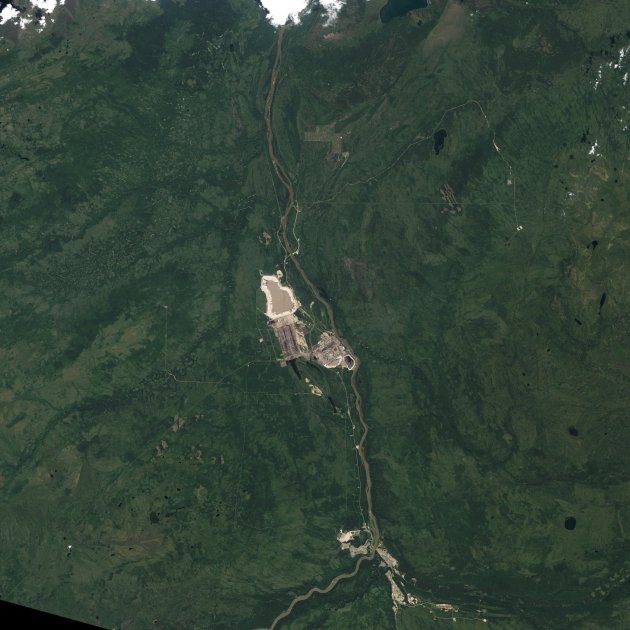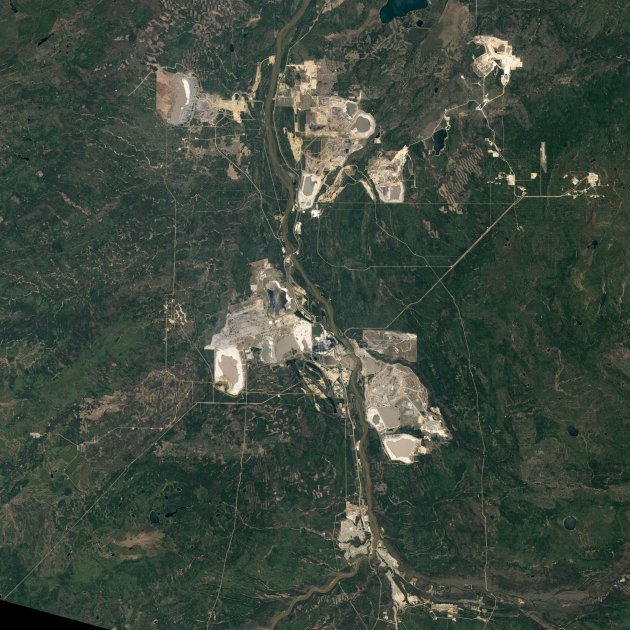President Obama has a very important decision to make in approving or rejecting the Keystone XL Pipeline. Tar sands production is one of the world’s most environmentally damaging activities. It wrecks vast areas of boreal forest through surface mining and subsurface production. It sucks up huge quantities of water from local rivers, turns it into toxic waste and dumps the contaminated water into tailing ponds that now cover nearly 70 square miles1.
This is a map of of the world distribution of the Taiga or Boreal Forest biome. Clicking on the map will take you to an explanation of this important biome, including its climate and its plant and animal species.
All four major flyways in North America — the aerial migration routes traveled by billions of birds each year — converge in one spot in Canada’s boreal forest, the Peace-Athabasca Delta in northeastern Alberta. More than 1 million birds, including tundra swans, snow geese and countless ducks, stop to rest and gather strength in these undisturbed wetlands each autumn. For many waterfowl, this area is their only nesting ground2.
About three billion birds fly north to the Boreal Forest each spring to build nests and lay eggs. These birds arrive in the Boreal Forest after spending the winter in South and Central America, Mexico, the Caribbean, and the United States. From the Boreal Forest Fact Sheet:
- 325 bird species – that’s almost half of all the bird species in North America! – depend on the Boreal Forest.
- About 3 billion of North America’s landbirds, 26 million of its waterfowl, and 7 million of its shorebirds breed here.
- There are nearly 100 species of which 50% or more of the entire population breeds in the Boreal Forest.
- Up to 5 billion birds – adults and their new babies – migrate south from the Boreal Forest each fall.
Back in 2008, the National Resources Defense Council (NRDC) wrote a report titled “Danger in the Nursery: Impact on Birds of Tar Sands Oil Development in Canada’s Boreal Forest” which covers various ways tar sand development affects bird populations including:
- Habitat loss
- Trailings ponds and oiled birds
- Fragmentation of habitat from drilling
- Water withdrawals
- Air and water toxins
- High emissions and climate change
Remember, this was back in 2008. Things have expanded since then. This is an aerial photograph of the Athabasca Oil Sands when things were slow in 1984.
This is a photograph of the same area in 2011.
Oil sand mining has a large impact on the environment. Forests must be cleared for both open-pit and in situ mining. Pit mines can grow to more than 80 meters depth, as massive trucks remove up to 720,000 tons of sand every day. As of September 2011, roughly 663 square kilometers (256 square miles) of land had been disturbed for oil sand mining3.
So, deforestation, loss of breeding grounds, miles of trailings ponds that look like lakes to migrating birds leading to death by oiling and drowning all take a toll on our bird populations. But wait, we haven’t even talked about climate change!
Because it takes energy to mine and separate oil from the sands, oil sands extraction releases more greenhouse gases than other forms of oil production. The mines shown in the image above emitted more than 20 million tons of greenhouse gases in 2008— a product of both oil production and electricity production for the mining operation. The effort produced the equivalent of 86 to 103 kilograms of carbon dioxide for every barrel of crude oil produced. By comparison, 27 to 58 kilograms of carbon dioxide are emitted in the conventional production of a barrel of crude oil3.
httpv://youtu.be/Sm7UplJXOz4
Then there is, as history shows, the certainty that there will be oil spills from the Keystone XL Pipeline across sensitive areas of the United States. Just look at the recent spill in Arkansas.
httpv://youtu.be/nUW4HvTg_Ig
As Michael Klare wrote in a recent piece for Mother Jones, “Presidential decisions often turn out to be far less significant than imagined, but every now and then what a president decides actually determines how the world turns. Such is the case with the Keystone XL pipeline, which, if built, is slated to bring some of the “dirtiest,” carbon-rich oil on the planet from Alberta, Canada, to refineries on the US Gulf Coast. In the near future, President Obama is expected to give its construction a definitive thumbs up or thumbs down, and the decision he makes could prove far more important than anyone imagines. It could determine the fate of the Canadian tar-sands industry and, with it, the future well-being of the planet.”
“The stakes in this battle could not be higher. If Keystone XL fails to win the president’s approval, the industry will certainly grow at a far slower pace than forecast and possibly witness the failure of costly ventures, resulting in an industry-wide contraction. If approved, however, production will soar and global warming will occur at an even faster rate than previously projected. In this way, a presidential decision will have an unexpectedly decisive and lasting impact on all our lives.”
httpv://youtu.be/xdelk-9mcR0
Now is the time to make a stand. We can’t afford allowing such an environmental disaster to continue unchecked. We need to make our voices heard.
This is a list of links that you can follow to contact your government officials to voice your opposition to the Keystone XL Pipeline. Please send at least one letter or make at least one phone call to let your representatives know that you won’t stand for this insanity.
- Sierra Club
- Friends of the Earth
- National Resources Defense Council
- 350.org
- National Wildlife Federation
- League of Conservation Voters
References:1New York Times,2National Resources Defense Council,3Earth Observatory

















I’ve been reading a lot about the Keystone XL Pipeline, but this is the first to specifically explain the potential effect on birds. This would be devastating to so many species. Thank you for a very informative post.
Larry, I agree with Wendy. This is the first post that so succinctly made that connection for me. I’ll be forwarding the link liberally. Thank you!
a very poignant post Larry, after watching the video presentation. Similar issues pursue our country also; you are bringing the news to those who care about our environs and in the hope of changing the minds of politicians and others who bring about catastrophic events for the sake of $$$
Larry you sure do your bit to enlightening everyone around you as to the tragic after-effects of mining procedures such as tar-sands oil projects. I watched the RR video before coming here. Best wishes,